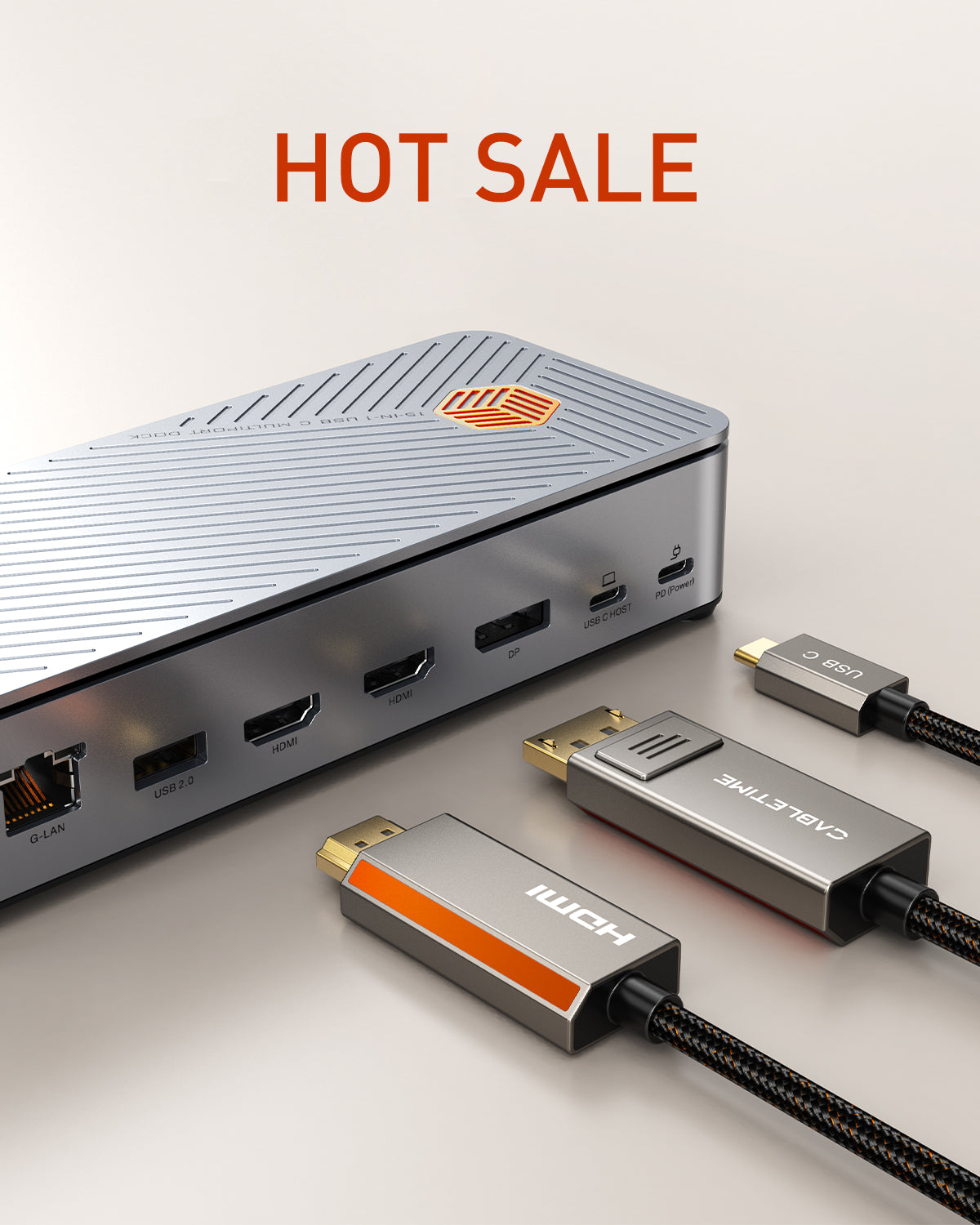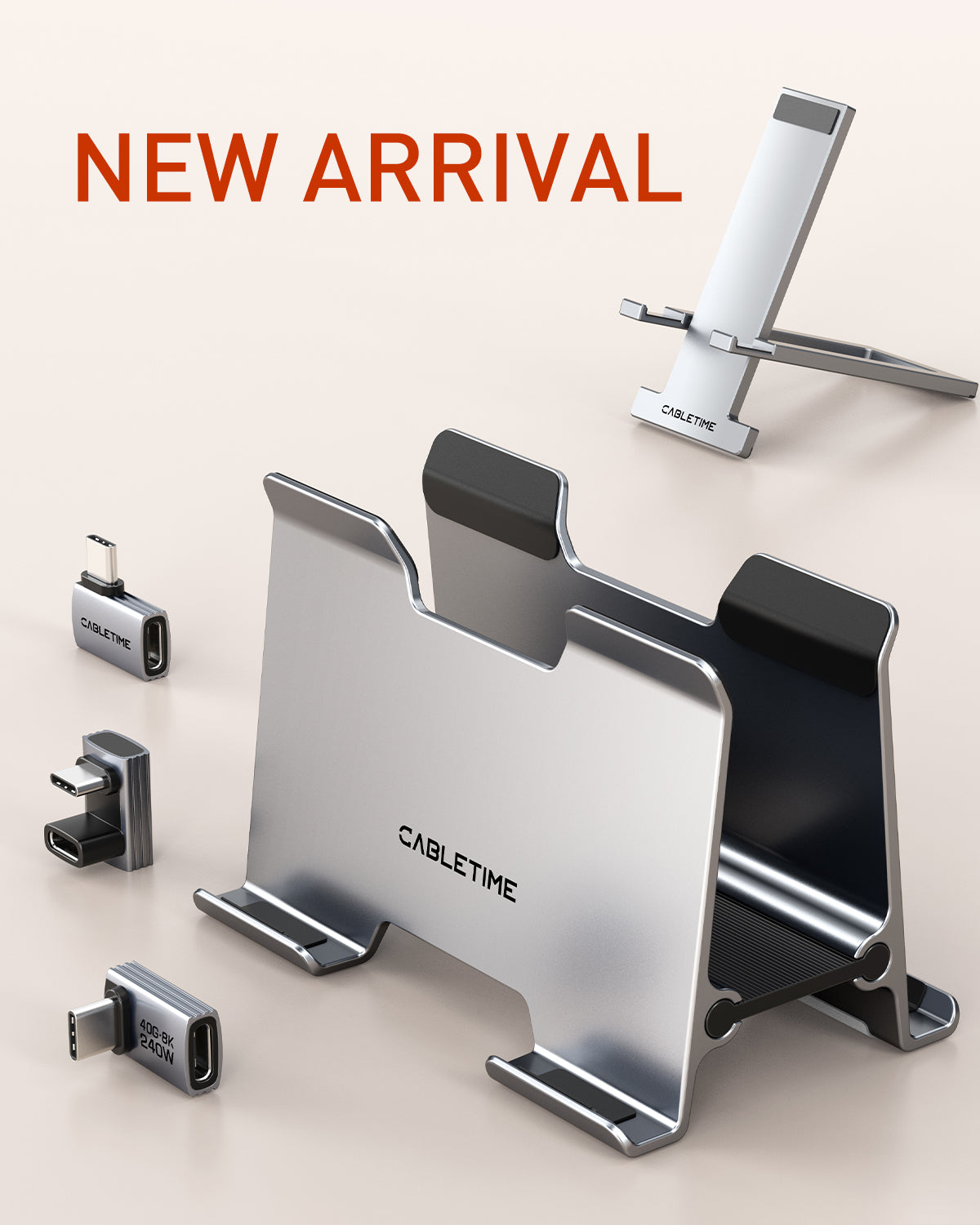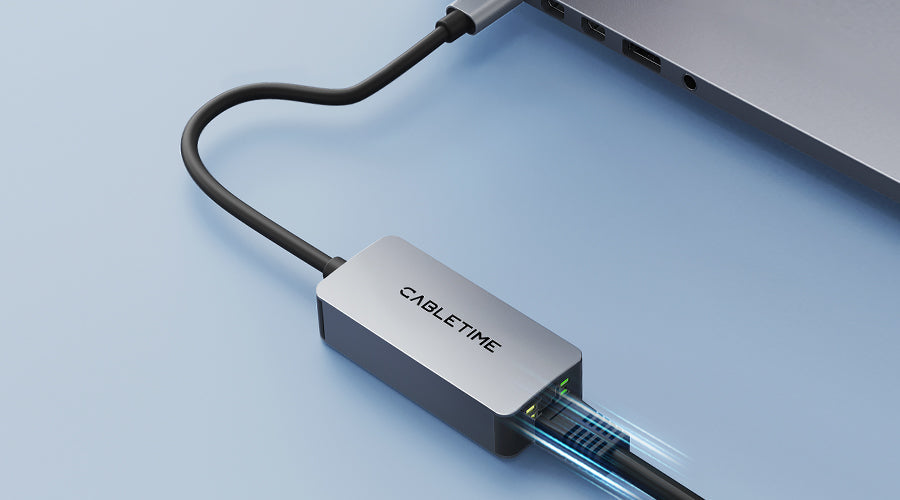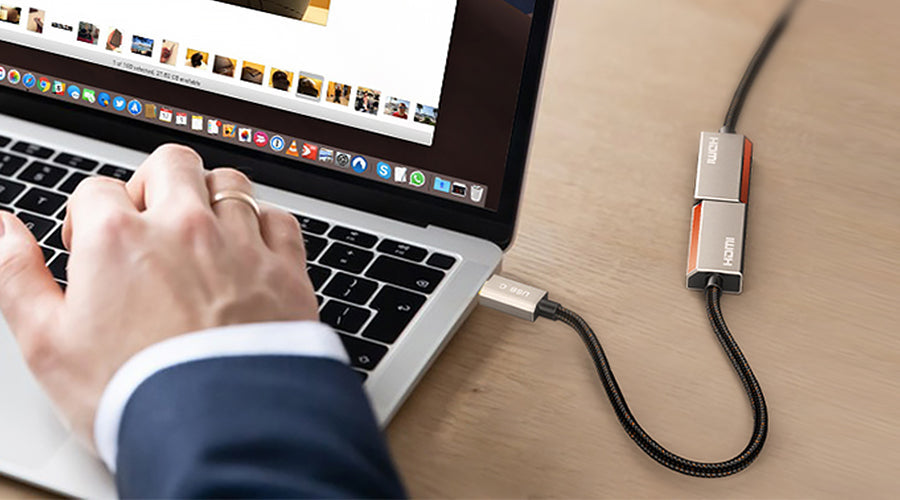An Ethernet adapter is essential hardware enabling your device to access Ethernet connections. It connects a USB port to an Ethernet cable, providing a more reliable alternative to shorter USB cables. The plug-and-play USB Ethernet adapter simplifies usage—just connect it to a USB port and link it to an Ethernet cable to enable multiple device connections. The user then links the other side of the Ethernet cable to another device for file transfer, sharing the Internet connection, and communication by application. USB-C, which connects computers and laptops to the Internet or local network via wired connections, is designed to improve the network by using existing wiring in the home.
In addition, new USB-C laptops and desktop computers have less port space and require an external Ethernet adapter to be wired.
Table of content
- 1. Types of USB Ethernet Adapters
- 2. USB Ethernet Adapter: Stability and Performance
- 3. Differences Between USB Ethernet Adapters and Regular USB Hubs
- 4. Network Card Feature Only Adapters vs. Adapters with Additional Ports:
- 5. Significant Improvements to the USB-C Ethernet Adapter
- 6. How to Choose a USB-C Ethernet Adapter?
- 7. USB Ethernet Adapter Requirements
- 8. Key Parameters to Consider
- 9. Conclusion
Types of USB Ethernet Adapters
USB-Ethernet adapters, also known as USB-LAN or USB-RJ45 adapters, provide a solution for devices that do not have an internal Ethernet port to connect to a wired network. There are several types of USB Ethernet adapters, depending on the USB interface you use. Here are some common types:
USB 2.0 Ethernet Adapter: 100Mbps

This type of adapter supports USB 2.0 and delivers a maximum data transfer rate of 100Mbps. Applicable for devices with USB 2.0 ports.
USB 3.0 Ethernet Adapter: 1000Mbps, 2.5Gbps

The USB 3.0 adapter provides a higher data transfer rate than USB 2.0, with a maximum speed of 2.5 Gbps. It is suitable for devices with USB 3.0 ports and provides faster and more reliable Ethernet connectivity.
USB Type-C - Ethernet adapter:1000Mbps, 2.5Gbps

With the growing popularity of USB Type-C ports, adapters are designed to provide Ethernet connectivity via USB Type-C. These adapters are versatile and can be used on laptops, tablets, and other devices with USB Type-C ports.
Thunderbolt Ethernet Adapter:
Some adapters are designed specifically for Thunderbolt ports. Thunderbolt is a high-speed interface, and the Thunderbolt-Ethernet adapter provides fast and reliable network connectivity.
USB hub with Ethernet port:

There is also a USB hub with an integrated Ethernet port. These hubs typically contain additional USB ports, which allow you to expand the connectivity options while providing wired network connectivity.
When choosing a USB Ethernet adapter, it is important to consider the types of USB ports available on your device (USB 2.0, USB 3.0, USB Type-C, Thunderbolt) to ensure compatibility. In addition, pay attention to the data transfer rates supported by both the adapter and your device to maximize network performance.
USB Ethernet Adapter: Stability and Performance
In the area of network connectivity, USB Ethernet adapters have become a valuable tool that provides a bridge between a device without an internal Ethernet port and a wired network. As users look for reliable, high-performance connectivity, it is critical to understand the stability and performance of these adapters. This discussion will delve into various aspects such as network transmission speed, comparison with normal network cards, impact of USB-C adapters, and the role of driver installation.
Highest Network Transmission Speed
There are different types of USB Ethernet adapters, each with its own functions. The USB 2.0 adapter operates at a maximum data transfer rate of 100Mbps and supports devices with USB 2.0 ports. Although this speed is slower than USB 3.0, it is sufficient for many applications, especially those that do not require large data transfers. However, with the advent of USB 3.0, the user has been significantly faster, up to 2.5 Gbps. This improvement is particularly advantageous for tasks involving large file transfers and high-resolution video streaming.
The USB-C Ethernet adapter leverages this interface to provide even faster data transfer rates. Depending on the specific USB-C standard (3.1, 3.2 Gen 1, 3.2 Gen 2), the user can experience speeds up to 1000Mbps or 2.5 Gbps. Because of this, USB-C adapters are at the forefront of high-performance network connectivity, making them the ideal choice for users looking for maximum speed and efficiency.
Performance of USB To Ethernet Adapters is comparable to regular network cards.
While the dedicated network card integrated into the motherboard of the device may have a slight performance advantage, the USB Ethernet adapter provides a portable and convenient solution and holds its position. In practice, the performance gap is often negligible in everyday networking needs. The USB adapter is versatile, allowing you to add an Ethernet connection to devices that don't have a built-in port, such as ultrabooks or tablets. The convenience and accessibility of USB adapters have become a preferred choice for users who prefer flexibility without sacrificing performance.
USB-C Ethernet Adapter Performance:
The USB-C Ethernet adapter stands out for its exceptional data transfer capabilities, offering a remarkable boost in networking performance. Users opting for the USB-C to Ethernet adapter can anticipate significant enhancements, particularly in tasks that demand substantial data processing. Whether it's facilitating large file transfers, high-resolution content streaming, or engaging in online gaming, the USB-C standard ensures a seamless and responsive networking experience.
Adding to its appeal is the user-friendly design of the USB-C connector, featuring a reversible orientation. This eliminates the need to worry about an "up" or "down" side, simplifying the connection process and reducing user frustration. The combination of advanced features and high performance makes the USB-C Ethernet adapter the preferred choice for individuals seeking not only maximum speed but also a hassle-free and streamlined user experience.
Performance in multi-device scenarios:
The internet speed of a USB hub with Ethernet ports is not necessarily the same as that of a USB Ethernet adapter. When multiple devices are connected, and ports are fully utilized, the performance of the USB Ethernet adapter becomes critical. While USB hubs with Ethernet ports offer more connectivity options, the simultaneous use of multiple devices can impact the speed of the entire network. In such scenarios, users should be mindful of shared bandwidth and consider using a powered USB hub to ensure consistent and optimal network performance.
Understanding the limits of shared bandwidth is crucial for users with high network demands. Although USB Ethernet adapters provide a valuable solution, connecting multiple devices simultaneously requires users to prioritize critical tasks, managing expectations to maintain satisfactory performance.
Driver Installation Requirements
The simplicity of the USB Ethernet adapter lies in its plug-and-play features. USB 2.0 and USB 3.0 adapters are designed to be recognized by the operating system without installing additional drivers. This user-friendly approach allows users to seamlessly connect the adapter, eliminating the need for manual configuration.
USB-C Ethernet adapters generally follow the same plug-and-play principle. Standardization of the USB-C interface ensures compatibility with a sort of device and operational systems and improves the user experience. In most cases, when the user connects the USB-C adapter, the system automatically recognizes and configures the device without installing drivers manually.
Differences Between USB Ethernet Adapters and Regular USB Hubs
USB Ethernet adapters focus on stable, high-performance networking, while regular USB hubs excel at managing multiple peripherals. The USB-C Ethernet adapter represents a significant advance, offering increased data transfer speeds and a user-friendly design for versatile, high-performance connectivity. Recognizing these differences is crucial for optimizing your setup.
USB Ethernet Adapter:

USB Ethernet adapters are primarily designed to provide Ethernet connectivity to devices that do not have an internal Ethernet port. It acts as an external network card, allowing devices such as laptops, tablets, and ultrabows to connect to a wired network. There is no use other than the Ethernet function, and the focus is on bridging the gap between the device and the wired network.
Regular USB Hub

A regular USB hub, on the other hand, functions as a multiport expander, allowing users to connect multiple USB-capable devices to a single USB port on a computer or laptop. While some USB hubs may have Ethernet ports, the primary function is to enable the connection of various USB peripherals, such as keyboards, mice, and external storage.
Hub performance varies with network card capabilities:
Hub Performance Differences Based on Network Card Functionality
USB Ethernet Adapter:

The performance of the USB Ethernet adapter is primarily related to the network function. These adapters are designed to provide a stable and reliable network connection. Performance is affected by factors such as USB interfaces (USB 2.0, USB 3.0, USB-C), adapter quality, and the ability of the network to connect.
Normal USB hub:
A typical USB hub is focused on managing data transfer between USB peripherals and host devices. Its performance is affected by factors such as USB standards (USB 2.0, USB 3.0, USB-C), the number and type of devices connected, and the power requirements of those devices. While some USB hubs have Ethernet ports and additional networking features, the main performance considerations are still in USB peripherals.
Network Card Feature Only Adapters vs. Adapters with Additional Ports:
Network Card Feature Only Adapter:
Some USB Ethernet adapters are specialized for Ethernet connections only. These adapters typically have one Ethernet port and no additional USB ports. Ideal for users looking for a solution to connect devices to a wired network without the need for multiple USB ports.
Adapter with Additional Port:

Other USB-Ethernet adapters come with additional USB ports that effectively act as USB hubs with Ethernet capabilities. These adapters provide users with the convenience of simultaneously extending both the network and the USB connection. Users can connect USB peripherals while enjoying the benefits of a wired network connection.
Significant Improvements to the USB-C Ethernet Adapter
Increased data transfer rate:
The USB-C Ethernet adapter takes advantage of the advanced features of the USB-C interface to significantly improve data transfer rates. Depending on the specific USB-C standard (USB 3.1, USB 3.2 Generation 1, USB 3.2 Gen 2), users can experience speeds up to 2.5 Gbps. This increased data transfer rate ensures high-performance networking, making the USB-C adapter a valuable asset for users with demanding connectivity needs.
Reversible connector and easy-to-use design:
The USB-C adapter uses a reversible connector, so you don't have to worry about the correct orientation when you plug in the cable. This user-friendly design improves the overall usability of the USB-C Ethernet adapter and makes it more accessible to users.
Diverse connectivity:
The USB-C is a versatile interface that supports not only Ethernet connectivity but also various functions such as data transfer, video output, power supply, etc. The USB-C Ethernet adapter benefits from this versatility, providing users with multiple capabilities at a single, standardized connection point.
Device-to-device compatibility:
USB-C is a widely adopted standard in various devices such as laptops, tablets, smartphones, and peripherals. The USB-C Ethernet adapter is compatible with this standard, providing compatibility for a wide range of devices. Users can seamlessly connect these adapters to USB-C-enabled devices without worrying about compatibility.
How to Choose a USB-C Ethernet Adapter?
When choosing a USB-Ethernet adapter, you should carefully consider your specific needs and adapter capabilities. Whether you're upgrading your laptop, tablet, or desktop networking capabilities, you can make informed decisions by understanding when you need these adapters and the key parameters to consider.
Whether it's USB or USB-C, understanding how these adapters are needed and paying attention to critical parameters such as network speed, adapter capacity, and additional device connectivity allows you to make an informed decision to meet your connectivity requirements.
USB Ethernet Adapter Requirements

The device does not have an internal Ethernet port:
The most common scenario where a USB-Ethernet adapter is required is when your device does not have a built-in Ethernet port. Many ultrabooks, slim laptops, and tablets are designed to be sleek and often sacrificed for essential ports, including Ethernet. In such cases, USB Ethernet adapters are a valuable tool to provide wired network connectivity.
Need a stable, reliable network.
In situations where a stable and reliable network connection is critical, it makes sense to choose a USB-Ethernet adapter. Although Wi-Fi is convenient, wired connections offer low latency and stable speeds, making them ideal for online games, video conferencing, large file transfers, and other activities.
Enhanced security:
Wired connections via a USB-Ethernet adapter are the preferred choice in environments where security is a top priority, such as corporate offices or special industries. In general, wired connections are considered safer than wireless connections.
Increase Internet speed:
If the Internet speed does not come up as expected with a Wi-Fi connection, the USB Ethernet adapter will make a big difference. Direct wire connection ensures optimal speed and reduces the possibility of signal interference, especially in areas where multiple Wi-Fi signals cause interference.
USB-C Ethernet Adapter Required

Latest devices with USB-C ports:
With the growing popularity of USB-C ports in modern appliances such as laptops, tablets, and smartphones, there is a growing demand for adapters from USB-C to Ethernet. If your device has a USB-C port and no built-in Ethernet port, this adapter is essential for wired network connectivity.
High-performance networking:
The USB-C Ethernet adapter is ideal for scenarios that require high-performance networking. Increased data transfer rates up to 2.5 Gbps with the USB-C standard make it particularly suitable for data-intensive tasks such as streaming 4K content, online games, and transferring large files.
Wide Range of Connectivity Needs:
Taking advantage of the versatility of the USB-C interface, these adapters provide multiple functions in a single solution. From data transfer and video output to power and Ethernet connectivity, the USB-C Ethernet adapter is designed for users with diverse connectivity needs. It offers a comprehensive solution on a single port.
Reversible connector and user-friendly design:
The USB-C connector is reversible, making it more convenient for users. The USB-C Ethernet adapter does not need to be plugged into a specific orientation, making it easy for users to connect. This user-friendly design contributes to the overall ease of use of these adapters and reduces the frustration associated with the orientation of the connectors.
Device-to-device compatibility:
The USB-C Ethernet adapter is compatible with a wide range of devices with USB-C ports and offers a wide range of compatibility. From laptops to tablets to smartphones, these adapters provide standardized and versatile solutions for users looking for wired network connectivity between USB-C-enabled devices.
Key Parameters to Consider
Maximum network speed:
When choosing a USB-Ethernet adapter, the maximum speed of the network is a very important parameter. Make sure that the adapter you choose is compatible with the maximum speed your network provides. For example, if you are using a Gigabit Ethernet connection with a maximum speed of 1 Gbps, choose an adapter with this speed for optimal performance.
Maximum adapter capacity:
Consider the maximum capacity of the adapter in terms of data transfer rate. USB 2.0 adapters are slower (up to 100Mbps) than USB 3.0 (up to 2.5Gbps) or USB-C adapters (up 2.5 Gbps or 1000 Mbps). By choosing the adapter capacity that matches your network needs, you can transfer data efficiently and at high speed.
A number of additional devices to connect:
Rate the number of additional devices that need to be connected to access the network. Some USB Ethernet adapters come with additional USB ports that can effectively act as hubs. If you're looking to connect multiple peripherals, such as external drives or USB accessories, the adapter with the port is a convenient, all-in-one solution.
Power Delivery (for USB-C adapters):
When choosing a USB-C Ethernet adapter, consider whether it supports power delivery. The power delivery feature of USB-C allows you to power devices while transmitting data. It is especially beneficial for laptops and tablets with limited USB-C ports, allowing you to charge your device and connect to a wired network at the same time.
Adapter quality and brand reputation:
For reliable and durable performance, the quality of the adapter is paramount. Choose an adapter from a brand that is reputed for quality and durability. By reading user reviews and taking into account the brand's reputation, you can invest in reliable and long-lasting USB Ethernet adapters.
Operating system compatibility:
Make sure the USB-Ethernet adapter is compatible with your device's operating system. Although most adapters are designed for plug-and-play use, checking compatibility allows for a seamless installation process without requiring additional drivers.
Cable length:
Consider the length of the cable of the adapter. Depending on your setup, you may need a long cable to reach your device comfortably. On the other hand, the shorter the cable, the easier it is to manage the cable without confusion.
Conclusion
In conclusion, the USB Ethernet adapter serves as an important bridge for seamlessly connecting devices that do not have an internal Ethernet port to the wired network. These adapters are available in a variety of types, including USB 2.0, USB 3.0, USB Type-C, and Thunderbolt, to meet a wide range of connectivity needs. Given the usefulness of USB Ethernet adapters, it is clear that they provide a stable, reliable network connection and are especially useful for devices that do not have an internal Ethernet port.
With high data transfer speeds of up to 2.5 Gbps on the USB-C adapters, the performance of the USB Ethernet adapter indicates that it is effective in meeting the requirements of data-intensive tasks. Despite some delays compared to a dedicated network card, the convenience and portability of a USB adapter have become a preferred choice for users who prefer flexibility without sacrificing performance.
Reversible connectors, increased data transfer speeds, and a wide range of connectivity options make the USB-C Ethernet adapter a symbol of significant advances in networking technology. Compatibility with a wide range of devices adds to its appeal, making it a versatile solution for users looking for optimal speed and ease of use.






Leave a comment
This site is protected by hCaptcha and the hCaptcha Privacy Policy and Terms of Service apply.